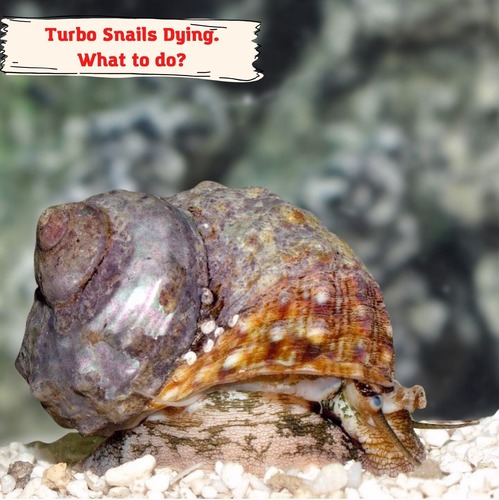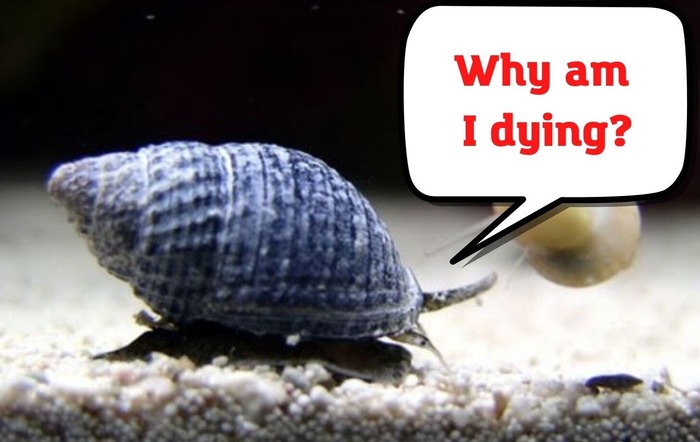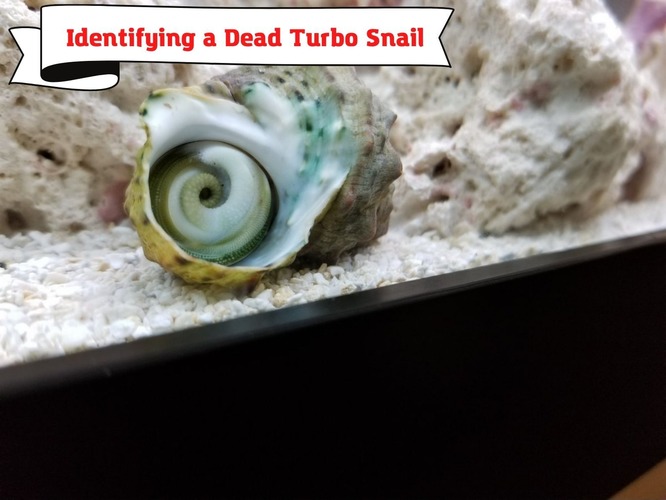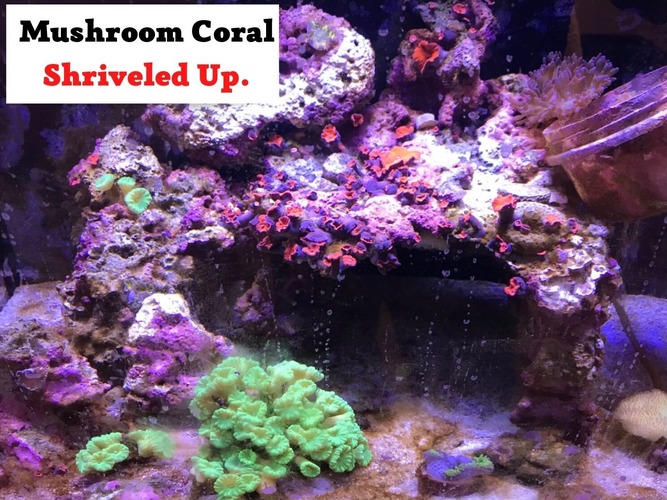
Turbo snails are a natural way of checking the algae growth in your tank. Their natural appetite for algae and the diligence with which they mow every inch of the aquarium for algae makes them an ideal choice of addition to the tank. But what could be the cause of your turbo snails dying?
This article explains the reasons your turbo snails are dying. It explains whether age or something about your aquarium could be the cause. It also answers other related questions about turbo snails.
After reading this piece, you will know:
- Some noteworthy facts about turbo snails;
- Why your turbo snails are dying and what you can do to prevent their death;
- How to identify a dead turbo snail;
- How to save a dying turbo snail.
Let’s get started!
About Turbo Snails
Turbo snails are from the family of Turbinidae and the Turbo genus. They usually come in shells that are thick and feature whorls. They have a strong operculum, a structure shaped to protect the soft part of the snail when it is retracted. The operculum is also thought to help snails resist total loss of moisture. The solid operculum also protects the snail from predators when it retracts its body into the shell.
Turbo snails are saltwater snails and should not be confused with fresh water and land snails. Also, turbo snails are notorious for feeding on algae, especially the hair algae. They are great biological tank cleaners. Their habit includes mowing around all the regions of the aquarium. They also fall often and cannot flip themselves over when they fall. This makes them easy prey for wrasses and hermit crabs.
Turbo snails usually grow up to 5.5cm and more. Their shells are hard and usually shaped like a dome. They have muscular feet, and they use them to move around. Turbo snails are nocturnal animals, but they sometimes come out during the day to wander around the aquarium walls and live rocks for food.
Turbo snails are of the Mollusca phylum. They have exoskeletal and require calcium to build their shells. If you have turbo snails in your tank, it would be best to ensure that the calcium levels are sufficient so that they can build strong shells. They are peaceful creatures and will get along fine with other tank mates who do not threaten their lives. But it would be best not to pair them with tank mates that also thrive on algae, such as Tangs. This will reduce the number of algae available to the turbo snails for consumption.
Why Are My Turbo Snails Dying?

There are many reasons your turbo snails are dying. These reasons are discussed below.
Predation
Unsuspecting aquarists make the mistake of pairing turbo snails with tank mates that are natural predators. Hermit crabs and wrasses are notorious for eating turbo snails. They usually wait for the snail to fall on its back before going after it because turbo snails can not flip themselves over when they fall.
Many species of Triggerfish, among others, have been caught many times eating turbo snails. It would be best not to pair your turbo snails with aggressive fish that eat snails as tank mates.
Poisoning
If you decide to keep more than one fish in your aquarium, it is important to work out their compatibility rate. Ensure that what you feed one does not affect the other. For instance, turbo snails and many other saltwater snails are highly sensitive to copper and can die from copper poisoning. They can suffer harm from copper poisoning from the fertilizers and antibiotics you administer to other fish in the tank.
Incorrect Water Parameters
Your turbo snails are sure to die of inappropriate levels of nitrate, ammonia, and nitrite in your aquarium. Nitrite, nitrate, and ammonia are byproducts of the organic waste broken down in your aquarium by some special bacteria. They are toxic to your turbo snails and can lead to their death.
Overcrowding in the aquarium is one of the common causes of increased ammonia, nitrate, and nitrite levels. When your aquarium is crowded with fish and plants, the rate at which organic wastes to be broken down is produced increases. This leads to an increase in ammonia, nitrate, and nitrite, which are byproducts of the organic debris that are broken down.
Weekly water changes are a sure way to get rid of these lethal byproducts. It would also help to ensure that the nitrates and ammonia level is 0 parts per million (ppm). It would be best also to ensure that the pH balance is between 8-8.4 (alkalinity) and the water temperature is between 72°F to 84°F.
You should purchase a media or liquid test kit to read the water parameter daily. If you notice a change in the chemical levels, it would be best to change the water immediately.
Food and nutrition
Turbo snails are notorious for feeding on algae and leftovers of fish food. But these are not enough to keep your turbo snails alive. They may die of poor diet and nutrition if these are not supplemented with other foods.
Turbo snails are herbivores. They eat vegetables such as iceberg lettuce and zucchini, but the vegetables must be blanched before you feed them to your turbo snails. You can also feed them dried algae. You can place them between pieces of live rock to ensure that your snail has something to snack on. It would help if you also increased the calcium level in the water as they need calcium to build solid shells.
Aging
Age is another probable reason your turbo snail is dying. The lifespan of turbo snails in the wild is usually around three to five years. But in aquariums, turbo snails usually do not live beyond one and a half years. There have been reports of turbo snails living beyond two years in an aquarium.
This may not be hard to achieve if you can ensure that your tank is stable with the right water parameters and ensure its proper diet, nutrition, and care.
Identifying a Dead Turbo Snail

It is important to check your turbo snails regularly. The moment you feel that your snail is dead, you need to check it out. You will sense that your snail is dead when a horrible odor comes from its shell. When you nudge it gently on its muscular feet, and it doesn’t move, then it is dead. If the muscular part of the body hangs out of the shell, then your snail is dead.
What to Do When Your Turbo Snail Dies
The moment you notice that one of your turbo snails is dead, remove it immediately so that it does not contaminate the aquarium. If you fail to remove the dead turbo snail immediately, it will decay in the aquarium and pollute the tank for other inhabitants.
If you notice the death early or estimate the time of the death, you need just minimum changes. Remove it, check for lethal changes in the water parameters. Correct the water parameters with a partial water change if required.
But if you are unsure of how long your turbo snail died, it would be best to change the water and clean out the tank completely. This cleaning up will not only get rid of the decayed remains of the snail but will reduce the likely spread of disease in your tank.
Saving a Dying Turbo Snail
Sometimes, you may be lucky enough to catch the snail in the process of dying. This means you can still do a few things to save your turbo snail. What can you do? If your turbo snails turn themselves over and start dying, the likely reason they are dying is that they can not eat or move around after getting stuck. Their solid and heavy shells make it difficult for them to flip themselves. You can save them by helping them get back on their muscular feet if they have not been stuck for too long.
If the turbo snail has been stuck for too long and its health has deteriorated, the first thing to do is to separate it from the other inhabitants in the tank and put it in an isolation tank for treatment. After putting it in a quarantine tank, it would be best to tackle every possible problem that can cause the death of your snail. You would need to watch the water parameter of this quarantine tank closely to ensure that life threats are reduced to the barest minimum. Tackle the problem of diet and nutrition by providing your turbo snail with algae flakes and vegetables. Enhance the calcium level in the water to feed your turbo snail with enough calcium for shell growth.
Conclusion
Turbo snails are a beautiful addition to any saltwater aquarium. An unfailing way to ensure that your turbo snail is alive is through regular monitoring. Also, ensure that they have everything adequate, ranging from diet to living conditions. Understanding the nature and needs of your turbo snails is essential to prevent a high mortality rate.
- Snail Mantle Collapse – Here’s What Every Pet Owner Should Know - April 2, 2023
- Algaefix Killed My Fish – What Have I Done Wrong? - March 2, 2023
- How Long Can Live Rock Be Out of Water? And What Will Happen Then? - February 2, 2023




